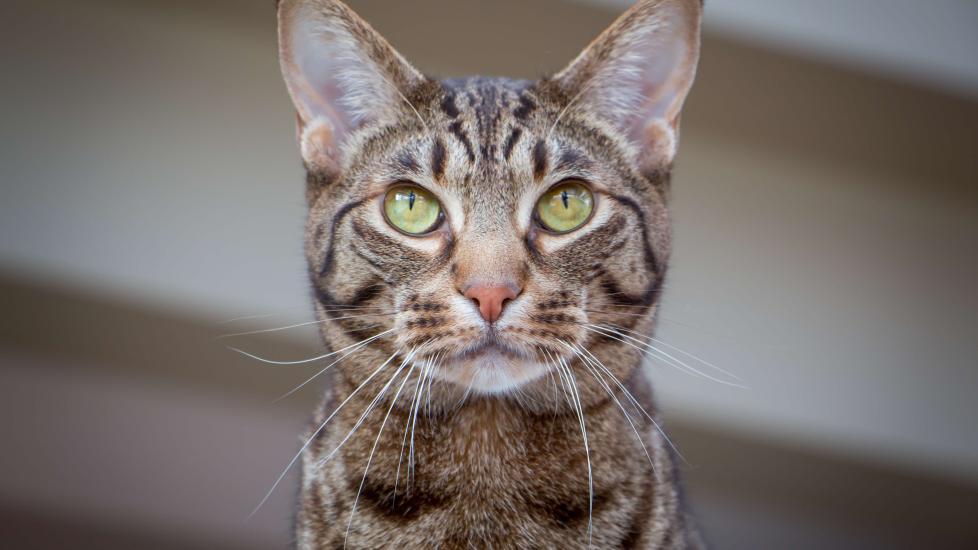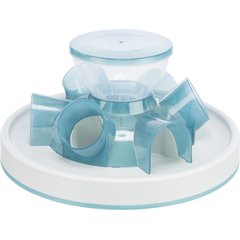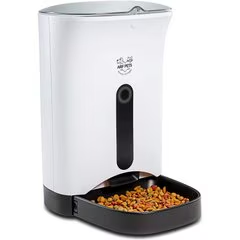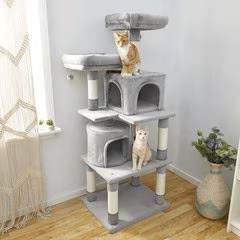Ocicat
Adobe Stock/Vicky
Sometimes the best things in life happen by pure accident—as was the case with the creation of the spotted Ocicat.
As the story goes, breeder Virginia Daly set out to breed a Siamese cat with the distinctive ticked coloring of an Abyssinian. After several breeding attempts, she was surprised to find a male kitten among the litter with eye-catching but unforeseen coloring, not unlike that of a wild ocelot. He had ivory fur adorned with golden spots.
This unexpected gem would be the first Ocicat kitten. His parents were reintroduced for breeding purposes, and after later incorporating the American Shorthair into the breeding program, the muscular and Ocicat we know today was established.
Caring for an Ocicat
Ocicats are medium to medium-large cats, weighing 6–15 pounds and measuring 9–11 inches at the shoulder. They’re confident cats that are highly devoted to their humans, so much so that the Ocicat and Classic Society call them “dogs in cats’ fur.”
But unlike dogs, these cats love to climb, often peering down on their humans from their favorite vantage points, whether it be a cat shelf, tall cat tree, or atop furniture.
Ocicat Health Issues
With an average lifespan of 12–18 years, the Ocicat can enjoy a long and happy life with proper care. Nonetheless, they may be susceptible to certain health issues, making pet insurance a good consideration for pet parents.
Amyloidosis
Amyloidosis is typically an uncommon condition in cats, but it’s believed that Abyssinian and Siamese (among other breeds such as Burmese, Tonkinese, Devon Rex, and Oriental Shorthairs) carry a genetic mutation that increases their vulnerability. This genetic condition can therefore be passed on to Ocicats.
Cats with the condition experience abnormal deposition of protein into tissues of the body—most commonly the kidneys. When too much protein builds up, it can disrupt the normal function of those organs, leading to conditions such as liver failure or kidney disease.
If your cat shows any of the following symptoms, contact your veterinarian right away:
-
Changes in appetite
-
Dull, unkempt and/or matted coat
-
Yellowing of the whites of the eyes, skin, and/or other mucus membranes
-
Depression and weakness
-
Fluid accumulation under the skin, in the abdomen, and/or in the chest
Pyruvate Kinase (PK) Deficiency
Pyruvate kinase (PK) deficiency is another genetic condition Ocicat kittens can inherit from their breeding parents. Fortunately, PK is rare in Ocicat kittens because reputable breeders test both breeding parents and the litter for PK genes before breeding. The condition can lead to anemia and other blood-related problems in cats.
Progressive Retinal Atrophy (PRA)
Progressive retinal atrophy (PRA) is a genetic eye condition frequently reported in Abyssinian cats and less commonly in Siamese cats, leading to degeneration of the retina. Initially noticed by pet parents as night blindness around 1 or 2 years of age, it progresses to complete vision loss.
Fortunately, responsible breeding practices help minimize the PRA in Ocicat kittens by selecting breeding parents that don’t carry the gene. However, if a kitten does inherit the disease, blind cats can still lead long, happy lives with special care.
What To Feed an Ocicat
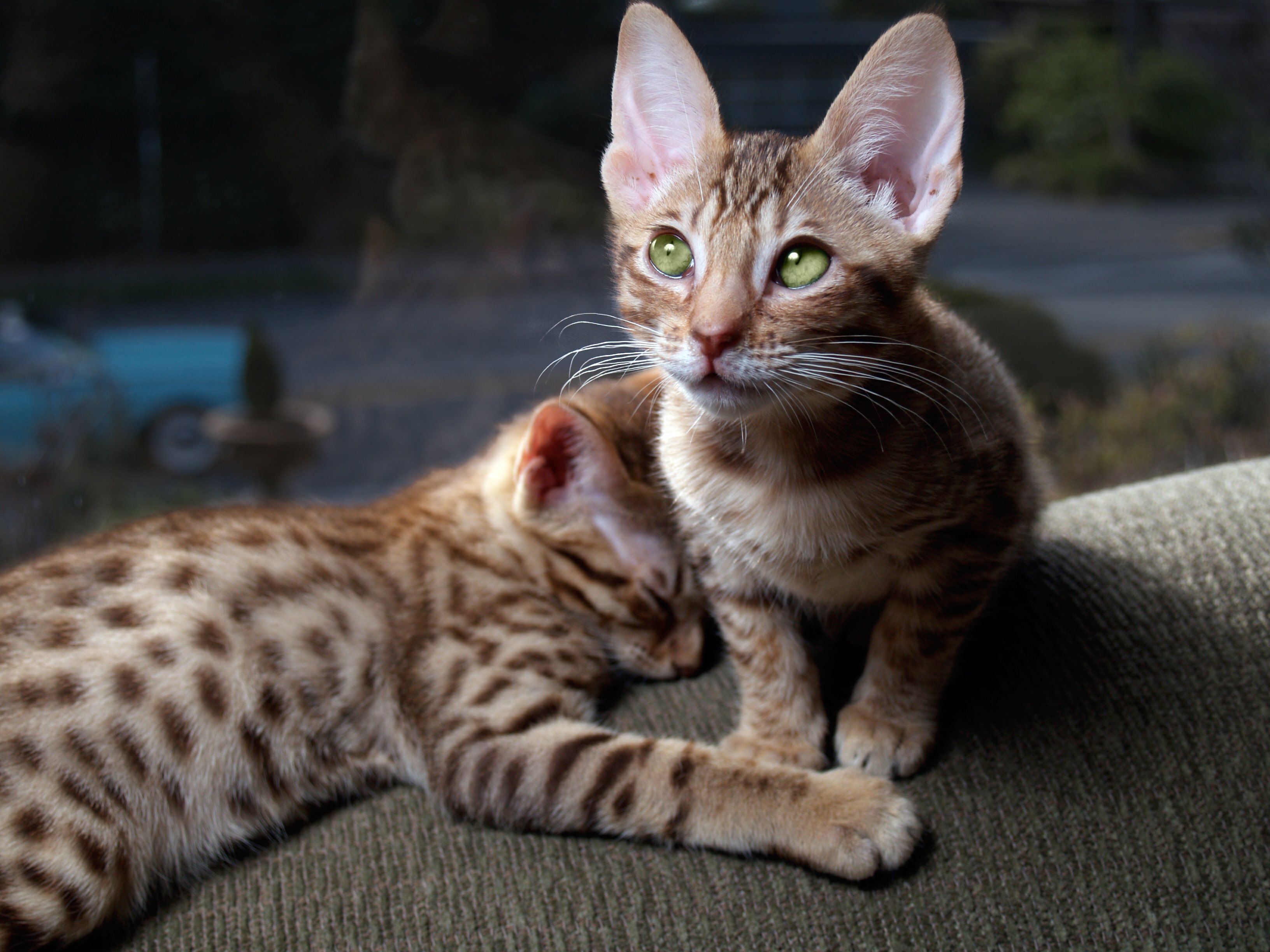
Ocicats should eat a commercial cat food diet, which includes animal protein-rich food labeled with a nutritional adequacy statement for their life stage from the Association of American Feed Control Officials (AAFCO).
Keep in mind that an Ocicat kitten shouldn't eat the same food as an adult Ocicat. Kitten food is formulated with higher levels of nutrients, fats, and proteins to support growth, while adult cat food provides the appropriate balance of nutrients to maintain a healthy weight.
As your cat reaches their senior years, ask your vet if switching to a senior diet could benefit your kitty. Consulting with your vet throughout your cat’s life will help you choose the right food.
How To Feed an Ocicat
Generally, feeding your Ocicat can be approached in two ways: timed meals or free-feeding (leaving food out all day). Ultimately, the best choice depends on what works best for you and your cat.
While free-feeding offers convenience, it can lead to excess weight gain if your cat tends to overeat. On the other hand, timed meals establish a routine and allow you to monitor your cat's daily intake. You can even increase mealtime enrichment by occasionally replacing your cat’s standard bowl with a puzzle or slow feeder. For those away from home during the day, an automatic feeder can help you manage timed feedings.
Recommended Products
How Much Should You Feed an Ocicat?
The amount of food you feed your Ocicat depends on their age, lifestyle, weight, and health conditions. Your veterinarian will use the body condition scoring system to determine if your cat is underweight, overweight, or at their ideal weight, which will help you and your vet determine their ideal calorie intake.
Until you're able to consult with your vet, use the serving size guidelines printed on the packaging of your cat food to determine the right portions for your cat.
Nutritional Tips for Ocicats
Generally, healthy cats don’t require supplements if they’re eating an AAFCO-compliant food. However, if you’re wondering whether your cat may benefit from supplements, such as fish oil for healthier skin and a shiner coat, consult your vet before incorporating them into their diet.
As your cat ages or if they develop medical conditions, your vet may recommend a diet that’s enriched with extra nutrients or suggest adding supplements to their meals.
Behavior and Training Tips for Ocicats
Ocicat Personality and Temperament
Don’t let her wild looks fool you: Ocicats are smart, social cats that show no shortage of attention or affection to their pet parents. Look up or behind you, and your Ocicat is likely there. That's if you don't hear them first; while they’re a touch less vocal than their Siamese parent, Ocicats often have something to say, even if it’s only a rumbling purr to show their content.
Their good nature isn't only toward humans. When given the chance to be properly introduced, they tend to get along well with other pets, including cats and dogs. Because they’re so active and social, Ocicats may prefer homes with other pets, particularly if they'll be alone while their humans are at work.
Ocicats love to climb, often peering down on their humans from their favorite vantage points, whether it be a cat shelf, tall cat tree, or atop furniture.
Ocicat Behavior
No matter their age, Ocicat cats need plenty of exercise and benefit from several interactive play sessions a day. They may even show off their doglike antics by fetching their favorite toy!
Because they form such strong bonds with their family, Ocicats are prone to separation anxiety. Playing with your cat before leaving for work, as well as providing plenty of stimulating toys, furniture to climb, and perhaps a perch in their favorite bird-watching window, can all help them pass the time.
Ocicat Training
Ocicats possess the trifecta of qualities ideal for training: intelligence, adaptability, and a strong desire to bond with humans. Whether you're seeking a feline travel companion or envision a kitty companion adept at learning unique tricks, the Ocicat is eager to be your cat. They take well to a harness and leash, but it’s not recommended that they be allowed to free-roam outdoors.
Fun Activities for Ocicats
-
Watching birds from a catio
-
Walking on a harness and leash
-
Climbing, pouncing, and jumping
-
Playing interactive games with their humans
-
Cuddling their humans
-
Playing with other pets
-
Solving food puzzles
Ocicat Grooming Guide
The Ocicat is a striking blend of Siamese, Abyssinian, and American Shorthair characteristics, resembling the wild ocelot in appearance. They have agouti spotted coats, meaning each strand has a dark band, a light band, and a dark tip, creating a ticked or shimmering effect.
Ocicats have a sturdy, athletic build and short, velvety fur, with rows of spots along the spine and large thumbprint-like spots across the torso. They come in 12 colors, and you can find chocolate, cinnamon, and gray Ocicats.
Skin Care
Ocicats typically don’t have oily or sensitive skin, so they don’t require a special skincare routine. However, their parent Abyssinian breed loves water, so perhaps you’ll find your Ocicat wants to join you in the tub.
Coat Care
While not hypoallergenic (technically, no cat is), Ocicats don’t tend to shed a lot. They’ll benefit from a weekly brushing, which doubles as quality time bonding with your cat.
Eye Care
Genetic eye conditions are uncommon when Ocicats are purchased from a reputable breeder. However, if you notice changes in your cat’s vision, such as bumping into objects at night, schedule a checkup with your veterinarian.
Other common eye problems in cats include eye infections, which you might notice if your cat is rubbing their eyes or has watery or red eyes.
Ear Care
Unless your veterinarian recommends it, there’s no need to regularly clean your cat’s ears. However, you should routinely check them for signs of ear infections, such as abnormal discharge, dark specks that look like coffee grounds (mites), or a foul smell from the ears. You might also notice your cat pawing at their ear or shaking their head.
If you notice anything unusual, schedule a checkup with your veterinarian.
Considerations for Pet Parents
Despite their wild appearance, Ocicats are anything but aloof. Pet parents of the wild-looking cat should be prepared to dedicate ample time to bonding, playing, and even training their cat.
Adopting or purchasing another cat (or even a dog!) along with your Ocicat can help provide them with the social and physical enrichment they love. Before welcoming your Ocicat home, prepare by adding plenty of cat-friendly amenities, such as cat trees for climbing, napping, and perching, as well as scratching posts, shelves, and perches to cater to their natural instincts.
Recommended Products
Ocicat FAQs
How much does an Ocicat kitten cost?
Ocicat kittens typically cost $1,300 to $1,700.
Is an Ocicat a good pet?
Ocicats are fantastic additions to families with children, active households, or those with other pets. Known for their adaptability and sociability, Ocicats happily integrate into various living situations. However, like any pet, care should be taken in introducing an Ocicat to new pets and in teaching children how to interact with pets.
Are Ocicats rare?
Ocicats are relatively uncommon. Consequently, finding an Ocicat at a local shelter is unlikely. Purchasing a kitten from a reputable breeder may require a substantial financial investment and traveling across state lines.
